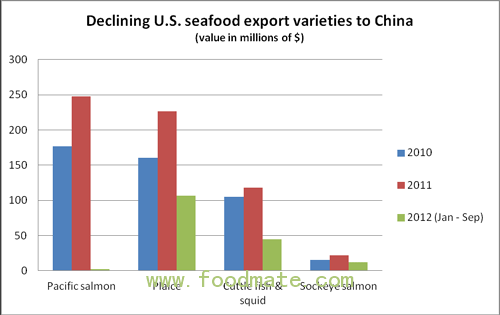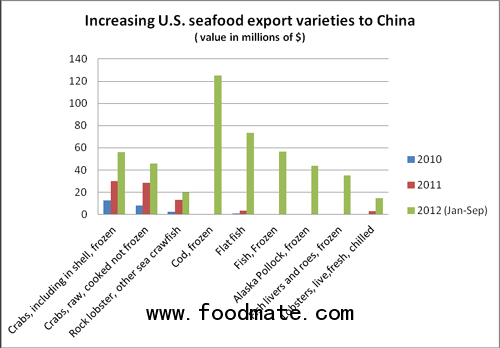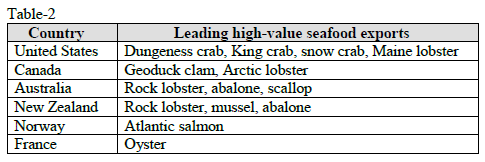Growing domestic incomes and changing life styles of average consumers is fueling demand for many high value seafood species creating abundant opportunities for US exporters.
In 2012, several high-end US seafood exports grew at a faster pace than the traditional US seafood exports to destine for north China’s processing and re-export industry.
Though overall consumer spending has declined for a number of food items (including imports), many high-end US seafood exports have slowed down not because of the decline in demand, but because of tighter inspection procedures and sting operations for trade entering through grey channels.
A New Seafood Superpower
Overall China has become a seafood superpower and is playing a significant role in the global business not only as the largest consumer, but also producer, exporter and importer of seafood products in the world, representing nearly 40 per cent of total global production based on China Customs data.
According to the most recent statistics by China’s Ministry of Agriculture (MOA), China exported 2.72 million tons of fish and seafood products worth $13.45 billion in the first three quarters of 2012, respectively, a 4.4-per cent decrease in volume and an 8-per cent increase value. In the first nine months of 2012, China imported 1.79 million tons of fish and seafood products, worth $3.92 billion, a 4-per cent increase in volume, but an 8-per cent decrease in value compared to the same period last year.
Russia continues to be the top supplier of China’s fish and seafood imports, follow by the United States who exported 476,224 tons of seafood products worth $1.13 billion to China in 2011, a 33-per cent increase in volume and 56-per cent increase value compared to the previous year. During the first nine months of 2012, US seafood exports to China were 280,774 tons, worth $726.52 million, a 16-per cent decline in volume and an 8-per cent decrease in value from the same period last year.
Three main categories of China’s seafood imports include:
1、High value seafood for domestic consumption, i.e. live high value seafood (lobster, crab, geoduck clam, etc.) and high value frozen seafood (fish roe, cod, etc.).
2、Seafood to be processed for re-exports, i.e. salmon, crab, dory, roughy, hoki and squid.
3、Fishmeal as animal feed (used widely especially in the early stages of an animal’s development --in the livestock and poultry husbandry and breeding operations)
Processing industry shows slowdown
According to the most recent MOA statistics, China processed and re-exported 821,800 tons of seafood worth $3.85 billion in the first three quarters of 2012, a 9-per cent decline in value and holding at the same value as last year. Shandong, Fujian, Guangdong, Liaoning, Zhejiang, Hainan, Guangxi and Jiangsu (in this order of volume and value) accounted for 95 per cent of Mainland China’s fish and seafood exports. There are several reasons for the drop:
1. Declining sales to Europe, Japan, and the United States and weak demand for value-added seafood products.
2. Rising labor cost trimmed down profit margins for local seafood processors.
3. The appreciation of Chinese RMB has eaten away at the already slim profit margin.
4. South China seafood processors started to re-locate to Southeast Asia, with less expensive labor costs.

Domestic demand continues to strengthen
1. South China’s seafood consumption is rising in line with increasing purchasing power. According to the Food and Agriculture Organization, seafood consumption in China is expected to reach almost 36kg per capita by 2020. Local consumer’s appetite for high value seafood continues amidst the slowdown in China’s consumer economy.According to MOA, during the first three quarters of 2012, China imported 1.02 million tons of seafood, worth $2.39 billion for domestic consumption, a nearly 4-per cent decline in volume but a staggering 17-per cent increase in value. Though local consumers still prefer purchasing high-end shellfish live, they do consume frozen and further processed mollusk products.
2. Live freshwater fish still dominates inland city markets, while frozen and processed products are more common in northern regions. Live seafood is popular among the wealthy residing in coastal cities.
3. Aside from the processed-for-export pattern in the North, South China remains the dominant high value imported seafood product consumption center. With the highest incomes in China, passion for seafood dishes, and the presence of a large number of seafood importers, distributors and supporting logistic and storage infrastructure, South China is the perfect destination for high value seafood.
Changing seafood varieties indicate the change to more domestic consumption
While we see a sharp decline in the traditional seafood products for processing, such as salmon, plaice and squid, some new products, including lobster, crab, cod and roe, pop up with tremendous increase, which mainly be consumed locally.


Food safety concerns create opportunities for imported seafood
Food safety remains an important concern for consumers. The emerging middle-class increasingly prefers non-polluted food. Local consumers also perceive imported products as safer and are thus willing to pay a premium for them. Meanwhile, seafood has long been regarded as nutritious and healthy being widely welcomed by consumers in every economic stratum.
Some high value seafood products, such as live lobster, crab, abalone and geoduck clam are symbols of luxury and economic status. So far, little branding of seafood has taken place in the local imported seafood market, but there is an increasing awareness of pricing based on the country of origin of the product in wholesale markets and some associations being made by consumers tying the quality of product to the country of origin.
Many consumers and restaurant owners in major cities for example can speak intelligently about their impressions of a number of seafood products from anywhere in the world.

South China is the largest distribution hub for live seafood imports in China
According to industry sources, over 80 per cent of live seafood imports to China arrive in Shenzhen (adjacent to Hong Kong). Shenzhen importers dominate most of the live seafood imports including distribution channels throughout Mainland China.
These traders have built networks in various major cities, including Guangzhou, Shanghai and Beijing. According to industry sources, more than half of the live seafood entering Shenzhen is sent to Guangzhou and then distributed to other cities in China (mainly coastal cities).
As the third largest air transportation hub after Beijing and Shanghai, Guangzhou is another important hub for high-value and live seafood imports. The Guangzhou Huangsha wholesale market is the largest live and high-end seafood market of its kind in all of Mainland China. Huangsha operates round-the-clock year round and generates $3.17 million in daily sales.
Huangsha houses around 300 companies, with 90 per cent of them dealing in the sales of live seafood. Over 60 per cent of US seafood sold in the market comes from Alaska. Shanghai has potential to become another major consumer and distribution hub for imported seafood, given per capita eating out expenditures and frequent direct flight paths.
Anti-smuggling campaigns have changed seafood trade
Since late last year, China Customs implemented a series of anti-smuggling measures nationwide. Customs reported two major successful crack-down cases widely broadcast in the media this past March in Guangzhou (mainly for live high value seafood worth $48 million) and April in Shanghai (mainly for high value seafood worth $102 million), many seafood traders are being more conservative in their purchase and immediately lowered their inventory to minimum levels to avoid any tantamount losses incurred by fines.
According to one industry source, another campaign is due in spring 2013. Meanwhile, some traders are switching purchasing through regular channels instead of relying on the grey channels to import these high-value products.
One area where most of the trade has fully converted to legal imports is in direct live air seafood shipments to Shenzhen, Guangzhou and Shanghai.
Depending on enforcement methods employed by the China Customs on anti-smuggling, the trade will decide whether to continue import through regular channels or swing back through the traditional grey channel to remain competitive in a fierce market.

Changing consumption patterns of frozen seafood
In major cities, more families are turning to ready-to-cook, processed seafood products, such as processed fish, shellfish, shrimp and prawns, thus, these items are becoming increasingly popular in hypermarkets.
The most widely seen US seafood products in local supermarkets include Pollock and cod, plaice and pacific salmon. There is also increasing opportunities to promote branded items to the young and affluent consumers, who increasingly prefer to shop in supermarkets.
Along with the growing middle-class with booming economies, the potential for high value seafood products remains promising.





